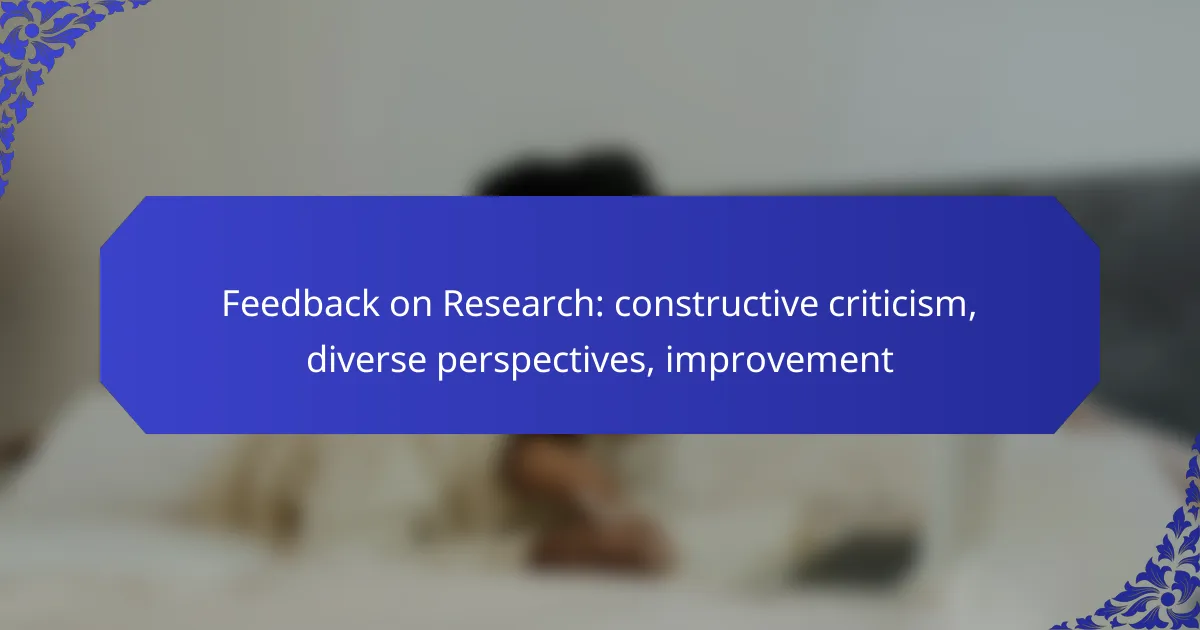Feedback on research is essential for enhancing its quality and credibility, as constructive criticism helps identify both strengths and weaknesses. By incorporating diverse perspectives through structured peer reviews, focus groups, and collaborative workshops, researchers can refine their work and ensure its relevance. Actively seeking and integrating this feedback fosters a culture of continuous improvement, ultimately leading to more robust findings.

How can constructive criticism improve research quality?
Constructive criticism enhances research quality by providing valuable feedback that identifies strengths and weaknesses. It fosters an environment where researchers can refine their work, ensuring that findings are robust and credible.
Enhances clarity and focus
Constructive criticism helps clarify the research objectives and focus by highlighting areas that may be ambiguous or poorly defined. When reviewers point out confusing elements, researchers can refine their questions and hypotheses, leading to a more coherent study.
For example, if a peer suggests rephrasing a research question for better clarity, it can lead to a more targeted investigation, ultimately improving the overall quality of the research output.
Identifies gaps in methodology
Feedback often reveals methodological weaknesses that researchers might overlook. Constructive criticism can point out flaws in study design, sampling methods, or data analysis techniques, which are crucial for ensuring valid results.
For instance, if a reviewer notes that the sample size is too small to draw reliable conclusions, the researcher can adjust their approach, potentially leading to more significant and applicable findings.
Encourages diverse viewpoints
Incorporating diverse perspectives through constructive criticism enriches the research process. Different viewpoints can challenge assumptions and introduce new ideas, leading to a more comprehensive understanding of the topic.
For example, feedback from individuals with varied backgrounds—such as different academic disciplines or cultural experiences—can uncover biases and broaden the scope of the research, making it more inclusive and relevant.
Promotes critical thinking
Constructive criticism fosters critical thinking by encouraging researchers to question their own assumptions and conclusions. Engaging with feedback prompts deeper analysis and reflection on the research process and outcomes.
Researchers can benefit from asking themselves why certain feedback was given and how it can be integrated into their work, leading to more rigorous and thoughtful research practices.
Facilitates collaborative improvement
Constructive criticism creates opportunities for collaboration, allowing researchers to work together to enhance the quality of their work. By sharing feedback, researchers can build on each other’s strengths and address weaknesses collectively.
For instance, forming a feedback group where researchers regularly review each other’s work can lead to ongoing improvements and innovations, ultimately raising the standard of research within a community or institution.

What are effective methods for gathering feedback on research?
Effective methods for gathering feedback on research include structured peer reviews, engaging focus groups, targeted surveys, and collaborative workshops. Each method offers unique advantages and can be tailored to specific research contexts to enhance the quality and relevance of feedback.
Peer review processes
Peer review processes involve having experts in the field evaluate the research for quality, validity, and significance. This method typically includes submitting work to a journal or conference, where it is assessed by multiple reviewers who provide constructive criticism.
To maximize the effectiveness of peer reviews, researchers should select reviewers with diverse expertise and backgrounds. This can lead to a more comprehensive evaluation and highlight different perspectives that may not have been considered initially.
Focus groups with diverse participants
Focus groups consist of small, diverse groups of individuals discussing the research topic, providing insights and feedback. This method allows researchers to gather qualitative data and understand how different demographics perceive their work.
When organizing focus groups, aim for a mix of participants in terms of age, gender, and professional background. This diversity can lead to richer discussions and uncover potential biases or blind spots in the research.
Surveys targeting specific audiences
Surveys are a practical way to gather quantitative feedback from specific audiences related to the research. By designing targeted questions, researchers can assess the relevance and clarity of their findings among different groups.
Consider using online survey tools to reach a broader audience efficiently. Aim for a response rate of at least 20-30% to ensure that the feedback is representative and actionable.
Workshops for collaborative critique
Workshops provide an interactive environment for researchers to present their work and receive real-time feedback from peers and stakeholders. These sessions encourage open dialogue and collaborative critique, fostering a culture of improvement.
To conduct effective workshops, set clear objectives and prepare specific questions to guide discussions. Limit the number of participants to ensure everyone has an opportunity to contribute, ideally keeping groups between 6-12 individuals.

How can researchers implement feedback effectively?
Researchers can implement feedback effectively by actively seeking constructive criticism, integrating diverse perspectives, and making necessary adjustments to their work. This process not only enhances the quality of research but also fosters a collaborative environment for continuous improvement.
Prioritize actionable insights
When receiving feedback, focus on insights that can be directly applied to your research. Actionable feedback is specific and provides clear steps for improvement, such as suggesting additional sources or methodologies. Prioritize comments that highlight areas needing clarity or further exploration.
To identify actionable insights, consider categorizing feedback into themes, such as methodology, data interpretation, and presentation. This helps in addressing the most critical areas first and streamlining the revision process.
Incorporate feedback into revisions
Integrating feedback into your revisions requires a systematic approach. Start by reviewing all received comments and selecting those that align with your research goals. Make changes thoughtfully, ensuring that each adjustment enhances the overall quality of your work.
For example, if feedback suggests a more robust statistical analysis, evaluate the feasibility of incorporating advanced techniques. Document these changes to track how feedback has shaped your research, which can be useful for future projects.
Maintain open communication with critics
Engaging in open dialogue with those providing feedback is crucial for understanding their perspectives. Encourage questions and clarifications to ensure that you fully grasp the intent behind their suggestions. This interaction can lead to deeper insights and foster a collaborative spirit.
Consider setting up follow-up meetings or discussions to address complex feedback. This not only shows appreciation for their input but also allows for a more nuanced understanding of how to implement their suggestions effectively.
Document changes made
Keeping a record of changes made in response to feedback is essential for transparency and accountability. Create a revision log that details what feedback was received, how it was addressed, and the rationale behind each change. This practice can be beneficial for both your personal growth and for sharing with collaborators or stakeholders.
Additionally, documenting changes helps in preparing for future reviews or publications, as it provides a clear narrative of how your research has evolved. This can be particularly useful when applying for grants or presenting your work at conferences.

What criteria should be used to evaluate feedback?
Evaluating feedback on research requires a focus on its relevance, feasibility, and potential impact on research quality. These criteria help ensure that the feedback is constructive and actionable, leading to meaningful improvements in the research process.
Relevance to research objectives
Feedback should align closely with the specific objectives of the research. This means assessing whether the suggestions directly address the research questions or hypotheses being explored. For instance, if the research aims to understand consumer behavior, feedback that suggests unrelated methodologies may not be useful.
To evaluate relevance, consider creating a checklist that matches feedback points against your research goals. This can help filter out suggestions that do not contribute to the intended outcomes.
Feasibility of suggestions
The feasibility of implementing feedback is crucial for practical application. Suggestions should be realistic given the available resources, time constraints, and existing methodologies. For example, recommending a complex statistical analysis that requires software not currently accessible may not be practical.
When assessing feasibility, consider the following: the time required for implementation, the skill set of the research team, and the availability of necessary tools. Prioritize feedback that can be realistically integrated into the research process.
Impact on overall research quality
Feedback should enhance the overall quality of the research, leading to more robust findings and conclusions. Consider whether the suggestions will improve the clarity, validity, or reliability of the research outcomes. For instance, feedback that encourages additional data collection may strengthen the study’s conclusions.
To gauge impact, reflect on how each piece of feedback could change the research’s trajectory. It may be helpful to categorize feedback into high, medium, and low impact based on its potential to elevate the research quality significantly.
